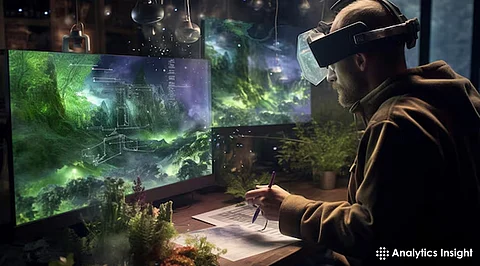

The gaming industry has witnessed speedy growth in the last few years. As the AI advancement has been influencing almost every sector, it is impossible that it doesn’t affect gaming. Therefore, as expected, the gaming industry is gradually implementing generative AI in developing games. This seamless integration of generative AI in game development has been taking the games to a new level with automated content creation and enhanced complexity and realism of non-playable characters.
Before diving deeper into how Generative AI transforms the gaming landscape, one should know the concept of Generative AI. Generative AI refers to artificial intelligence particularly designed for content generation and originality. It doesn’t really follow pre-made rules and generates images, music, and narratives by learning existing data.
When it comes to game design, Generative AI automates various aspects of it, including levels, environments, characters, and storylines. This automation process not only accelerates the game development process but also creates dynamic content for gamers that evolves based on how gamers interact with specific in-game elements. In most cases, it leads to creating a unique and engaging experience.
This is the most highlighted part of using Generative AI in gaming, but there’s more that the integration of AI does. Among them, one of the significant applications is Generative AI creates procedural content, where algorithms create expansive and varied game worlds without manual input.
This is one of the most useful things that Generative AI does to make the game development process easier and in-game worlds richer in detail. This approach allows developers to craft complex environments that adapt to player actions and enhance replayability and immersion. For instance, one can easily go for how AI-driven systems analyze player behaviors to adjust the game’s difficulty level so everyone can enjoy the game and not get annoyed easily.
The most important part is that Generative AI helps create realistic visuals for games. While playing games, visuals matter a lot, and they actually contribute the most to creating the overall atmosphere of the game. So, when these processes get automated, developers can focus on more creative decisions that foster innovation and efficiency.
Recently, Call of Duty: Black Ops 6 has used AI in developing some aspects of the game. Despite most gamers not approving the use of AI in poster designing, it shows that the trend of game development using AI is getting enhanced and renowned developer companies are integrating it into their process.
NPCs are an integral part of games. Whether one is playing an RPG or a battle royale, the involvement of NPCs is a must. Now, when it comes to NPC design, Generative AI is redefining this gaming sphere by designing the NPCs to exhibit life-like behavior. In fact, they engage in dynamic dialogues with gamers.
The best part is Generative AI makes the NPCs remember the past interactions and learn from the present behavior of gamers. Sometimes, these NPCs can be designed in a way, using generative AI, that they can pursue their own goals and motivations to create a more immersive and personalized gaming environment.
For example, let’s take Ubisoft’s NEO NPC project, where Generative AI has widened the boundaries for player-NPC interactions without compromising the authenticity of the gaming world. This makes the NPCs react in real-time to player actions. Similarly, companies like Inworld AI have been developing AI-driven NPCs who adapt to various scenarios and exhibit complex behaviors. These innovations enhance the depth and realism of the games.
The integration of Generative AI into gaming is significantly evolving the gaming industry. Of course, there are positive and negative effects of implementing AI in NPC development and in-game designs, but this makes games more realistic than ever with dynamic characters to interact with. As technology progresses, it seems like Generative AI will revolutionize the entire gaming landscape.
